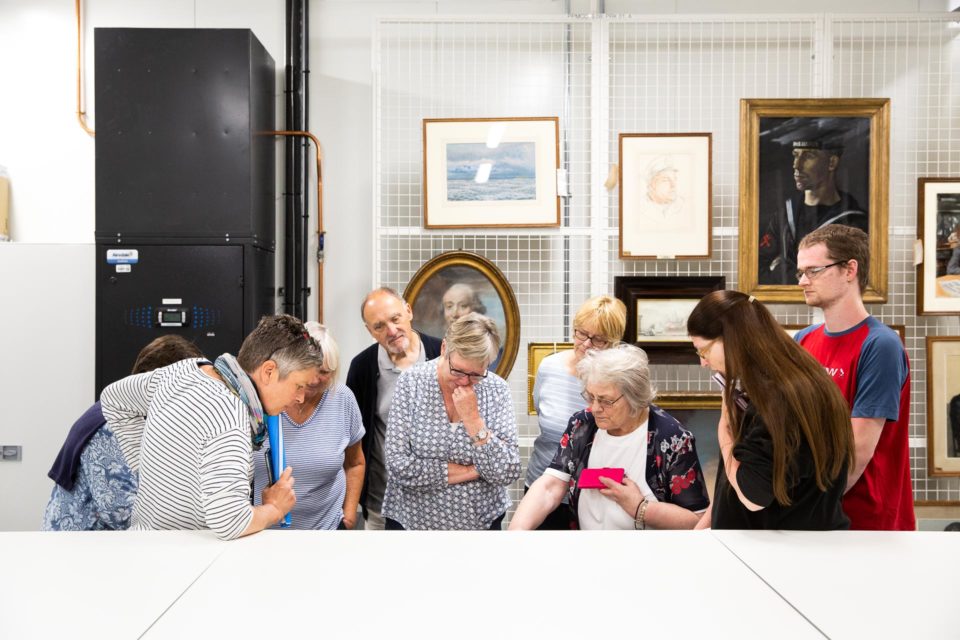I’m Helen Robertson and I’m Site Manager for Prince Philip Maritime Collection Centre.

Helen, can you talk us through your role here?
Working across facilities and public engagement, no two days are ever the same. It’s quite reactive and at the moment we’re in a period of development. In the first 18 months of this building’s life, the focus was predominantly on delivering collections and conservation as we were preparing to open four new permanent galleries covering 500 years of human endeavour. Now we’re moving into the next exciting phase which is all about opening the building to the public.
How did the building impact your ability to deliver the Endeavour project?
Well, we just couldn’t have delivered Endeavour without this building. There were so many objects to get through and that involves so much – moving them from store, all the conservation work and then photography as well. Previously, we were in a Victorian school building – we didn’t have the facilities to lift anything or to move objects between floors. This building has really improved that process. Objects are safely moved on trollies because we’ve got wide corridors, flat surfaces and lifts. And having an open plan office means that you communicate so much more.



So communication is very important to your work?
Oh yeah. We’ve always shared knowledge but the old building did restrict coordination. Every object will present a different story and will have different conservation needs. You have to be incredibly sympathetic to its history and the intentions for its use. So, we discuss most treatments because we’re dealing with science, art, craft and ethics. The other thing is, so many of our objects are mixed media. So for instance, if you’re looking at a ship model, we’ve got textiles on the sails, metals, wood and painted surfaces – so obviously you have to go to other conservators for advice.
The flow of the building – the ‘open-plan-ness’ of it, the immediacy and accessibility of the other studios – really lends itself to collaboration, cooperation and creating shared research and partnerships.
Do you feel there’s a community developing here?
This is the first time all departments have come together in one place. For all of us, we have one overriding aim and that is the best interests of the collection; its storage, its care, how we present it, even how we register it on the documentation side. So I think we’ve always been a community, but we were definitely more isolated in our separate departments. Being cross-departmental now, there is a more holistic view on what’s going on. We can better understand and appreciate the demands other departments are facing.

So when you come into the building, what do you feel?
I’ve always had a great sense of excitement about this building. We’re a little bit ahead of the curve in that we are and actually opening up our facilities and the experience here to the public. So I’m always excited to come in because you never know what’s going to happen.
This is a building of great potential and it’s up to us to make sure it lives up to that potential.
Can you tell us more about your plans to open the building up to the public?
The thing to remember is this isn’t our collection – it’s a national collection, it’s your collection. So the ultimate aim of the building and its design, is to be a publicly-accessible site.
We have learning spaces built in – we’ve got a seminar room, a classroom and the research room. And you’ll notice if you go into the store spaces and the conservation studios, areas have been left open to facilitate tours. We have the space to continue work but still be accessible to the public. That sort of forethought went into the design.
Obviously, we’ll never be a museum but I think it’s a wonderful thing to give people the opportunity to delve a little deeper. So many of us visit museums and take for granted that those objects are always going to be there, but a lot of work goes into ensuring they’re kept for generations to come. It’s exciting for us to be able to share our knowledge and our experience.


Has the building altered how you feel about your job?
It’s always a good thing to feel that you can try something new and develop your skills. Having the new facilities has pushed us in the treatments that we can undertake. Now we’ve got full extraction, we’ve got light, we’ve got space. And we’re investing in specialist analytical equipment. The building provides the space for us to be able to use that, and use it safely.
It feels more ‘22nd century cutting edge’ here. It’s great to feel that we can develop our own skills and move forward as a whole team to become a centre of true excellence. That was never going to happen in a Victorian school building.